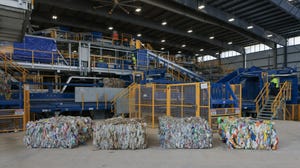Greenwaste Hauler USA Biomass Files for Protection Under Chapter 11
January 1, 2001
Brook Raflo
One of the nation's largest green- waste hauling companies has filed petitions under Chapter 11 of the U.S. Bankruptcy Code.
In the wake of a 16 cents per share net third quarter loss and plummeting stock prices, USA Biomass, Bell Gardens, Calif., announced last month that "inadequate cash liquidity" had forced the company to declare bankruptcy.
Three months ago, Biomass replaced its outgoing Chairman and Co-founder Fred Behrens with greenwaste processing entrepreneur Lance Jones.
Aiming to return the company to profitability by the first quarter of 2001, President and CEO Jones proposed a strategic growth plan targeting core acquisitions and shutdown of redundant facilities.
But declining stock prices "crippled" the plan, according to Jones.
"Our ability to use stock as a mold and a medium of acquisition diminished proportionately, and therefore we were stymied with additional acquisitions," he says.
Meanwhile, problems resulting from Biomass' March 2000 acquisition of American Waste Transport Inc. (AWT), San Diego County, Calif., had further depleted the company's capital.
In a press release, Biomass announced that AWT had not fulfilled obligations listed in the acquisition agreement, and that AWT had not disclosed certain material facts prior to the acquisition - facts that adversely affected the deal.
Consequently, Biomass re-ported it would cancel 1 million shares of AWT stock issued in connection with the acquisition.
Despite these challenges, Jones says Biomass has achieved some successes during the past few months.
"We were able to reduce monthly operational costs by up to $240,000 and were able to put in place revenue enhancements of approximately $140,000, with increased rates for trucking and various commodities," he says. "That was a significant stride."
However, these achievements did not come soon enough to prevent the lack of liquidity that precipitated Biomass' filing for Chapter 11, Jones adds.
For now, Biomass will focus on devising a plan to move forward.
"We intend to look at [our strategic plan] and scrutinize it very carefully during the next one to two months," at which point Biomass will present its plan to the court for approval, Jones says.
Recycling Watch: Christmas Trees Thirty-two million U.S. families celebrate the holiday season each year with a real Christmas tree.
Fifty-nine percent of U.S. Christmas tree-buyers say they recycle their trees through community programs.
The five most common uses for recycled Christmas trees are chip applications, beachfront erosion prevention, lake and river shoreline stabilization, fish habitat creation and river delta sedimentation management.
Ninety-eight percent of Christmas trees are grown on farms in the United States and Canada. The trees are planted to be harvested and re-planted, just as crops such as corn and pumpkins are harvested.
For each Christmas tree they harvest, farmers plant one to three new seedlings in its place, depending on farm size and current field rotation.
Source: National Christmas Tree Association, St. Louis
You May Also Like


